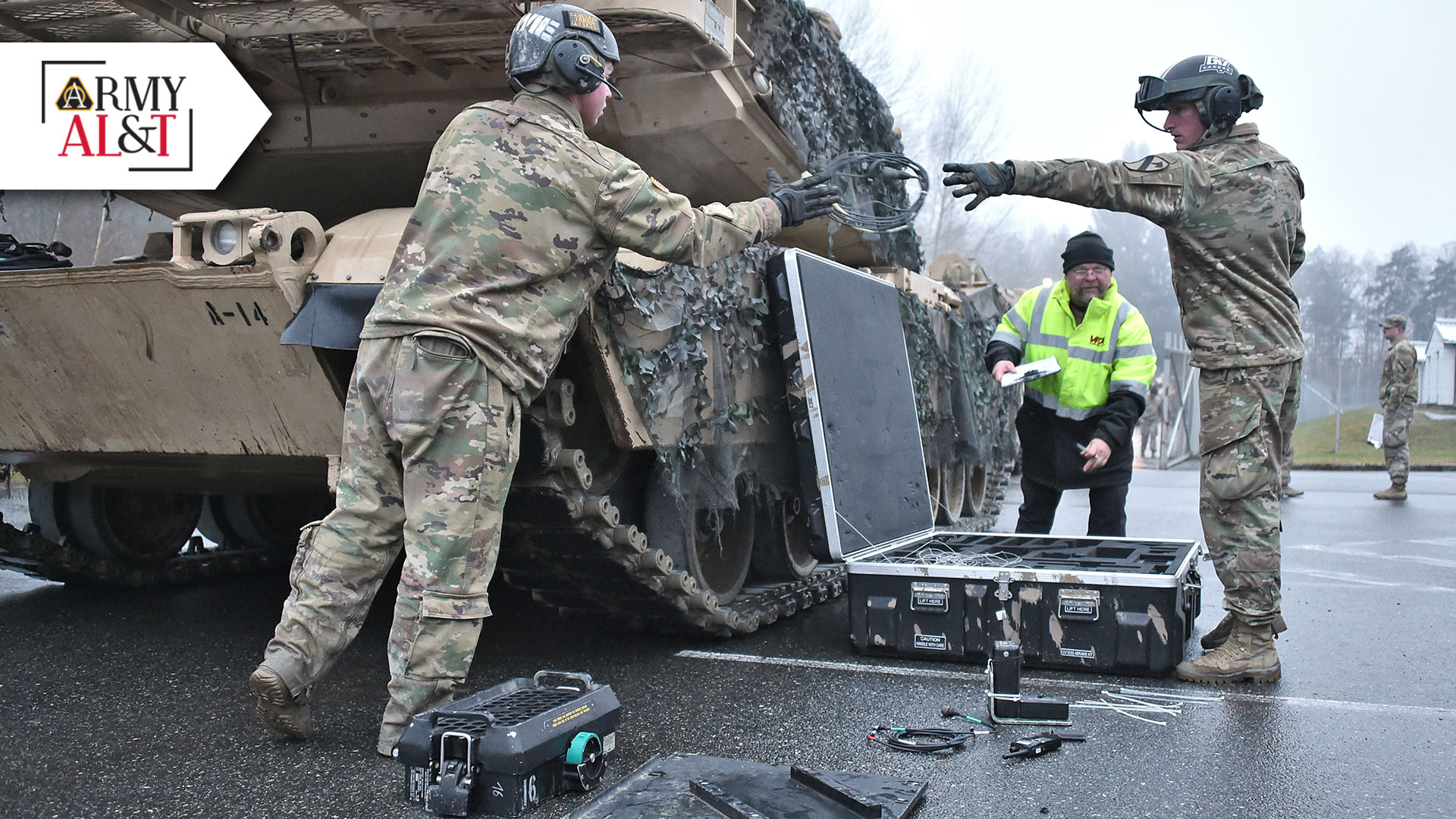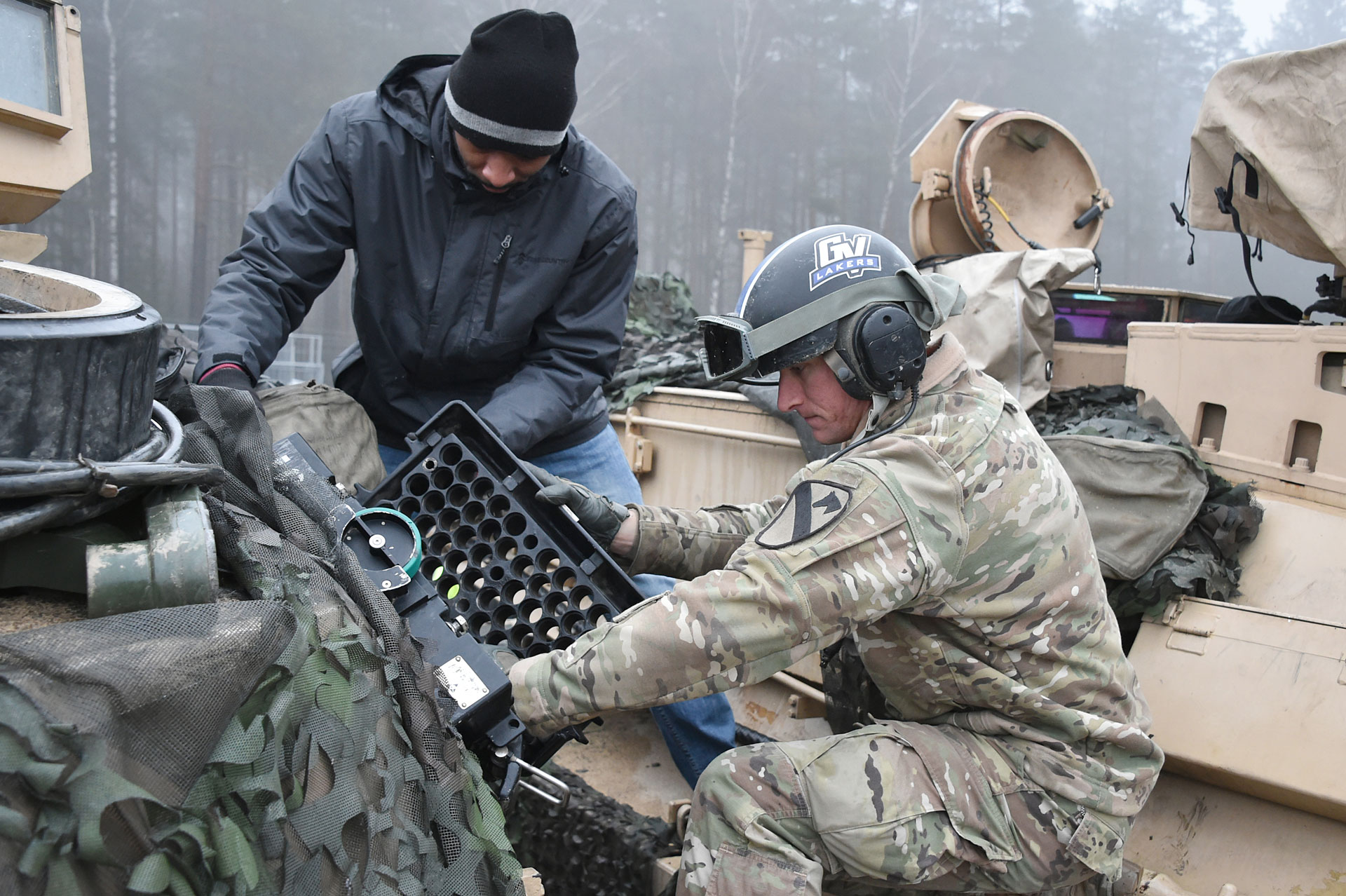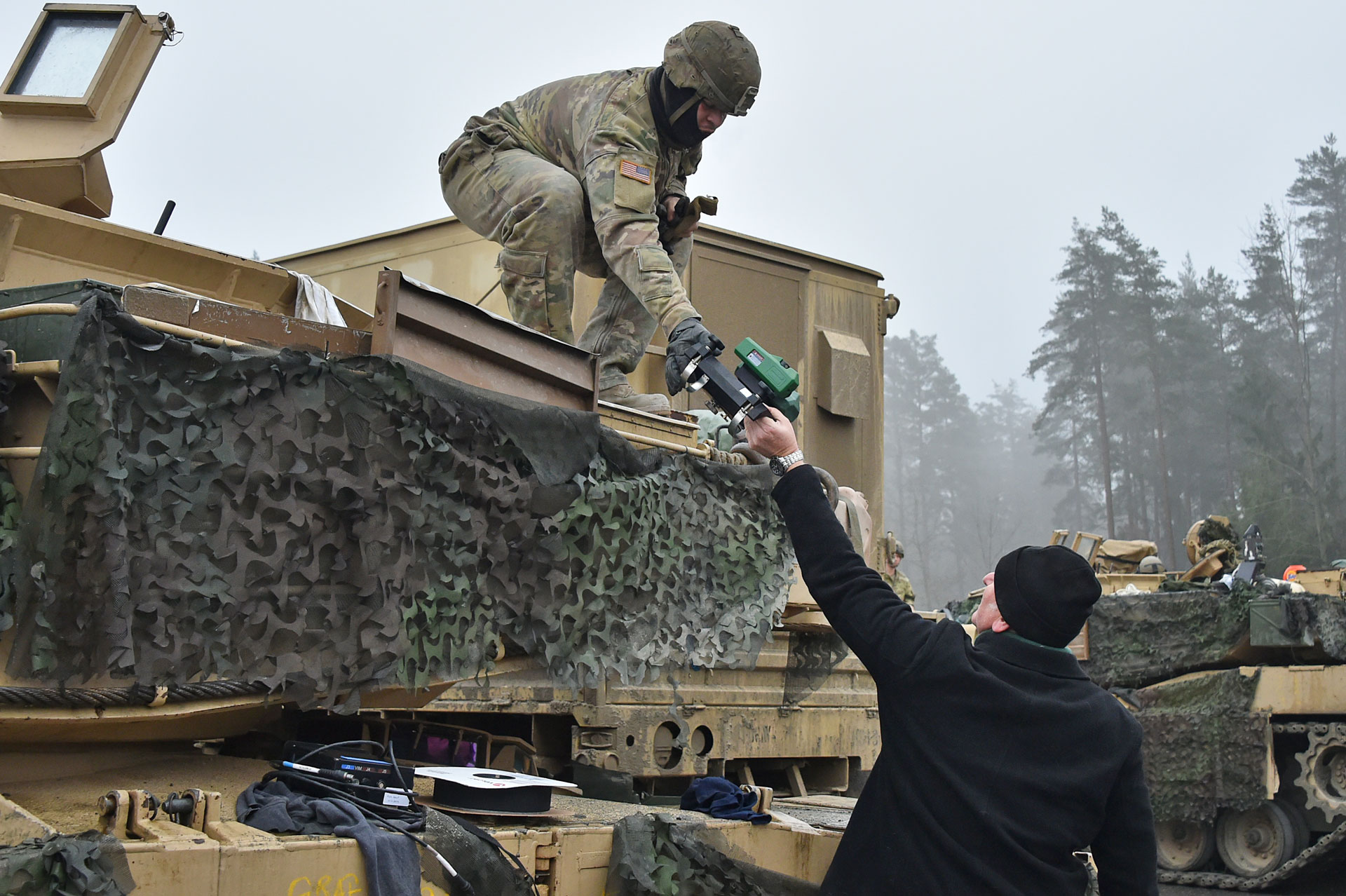
PRECISION DATA: The TESS is a laser-based system used in live simulation training. It calculates the pilot’s timing, accuracy, the target’s movement, armor and other data to produce scientifically precise hit-kill probabilities. (Photo by Gertrud Zach, Training Support Activity Europe)
As the Army focuses on modernizing its training capability, FMS provides allied nations with the most realistic experience outside of combat.
by Adriane Elliot
“We don’t rise to the level of our expectations; we fall to the level of our training.”
—Archilochus, Greek poet
A small first floor office in Orlando, Florida, is helping U.S. allies across the globe conduct the most realistic training possible outside of a battlefield.
The International Program Office (IPO) at the Program Executive Office for Simulation, Training and Instrumentation (PEO STRI) provides partner nations with training systems and training and sustainment services that strengthen both foreign allies and U.S. and coalition forces. The tiny office accomplishes this through one of the nation’s most vital foreign policy tools—security assistance and foreign military sales (FMS).
“Bolstering alliances and attracting new partners is a critical element of our national defense strategy, and that’s why our nation’s leaders continue to reinforce alliances as a priority,” said Dale Whittaker, the director of PEO STRI’s IPO. “They know, and everyone should know, that America’s allies and partners are critical to deter war and, if necessary, fight and win war.”
Whittaker said the manifold benefits of allied cooperation include everything from increased interoperability on the battlefield to partner agreements that enable freedom of movement and maneuver across the globe.

NEXT BEST THING: The TESS can provide “the very best training that is humanly possible outside of an actual battlefield,” Lujan said. (Photo by Gertrud Zach, Training Support Activity Europe)
“U.S. forces are simply not able to go uninvited into other countries and use their ports, roads, airfields and airspace. But all of that infrastructure is necessary to quickly move troops and equipment to the frontlines when necessary.”
“And that’s where you can really see the significance of America’s security assistance mission, and specifically the relationship-building that results from FMS,” Whitaker said. “Thanks to these relationships, we’ve already been training on the same equipment with our allies, so we’ve trained together and we know how to fight together. We already have prepositioned stock and country-to-country agreements in place that allow us to quickly maneuver both troops and combat-ready equipment and materiel across foreign terrain. Everything is already in place when we need it.”
STRONG ALLIES ARE GOOD DEFENSE
But there’s more to foreign policy and global security than warfighting, notes Whittaker. “There are a host of other threats we tackle alongside our allies through the use of security assistance.”
U.S. Secretary of State Antony Blinken echoed this sentiment in March, during his first visit to NATO Headquarters in Brussels.
“Americans look at the threats we face—like climate change, the COVID-19 pandemic, economic inequality, an increasingly assertive China—and they know that the United States is much better off tackling them with partners, rather than trying to do it alone. And all our allies can say the same,” he said.

STRENTHENING ALLIANCES: An FMS case might include the sale of an aircraft and the TESS to enable realistic training, enabling our allies to be successful. (Photo by Gertrud Zach, Training Support Activity Europe)
During his remarks, Blinken referenced a recent Chicago Council on Global Affairs poll that states that nine in 10 Americans believe that maintaining alliances is the most effective way to achieve U.S. foreign policy goals.
“Nine in 10. It’s not hard to see why,” said Blinken. “There’s a reason a vast majority of Americans support U.S. alliances, even if they’re divided along party lines on many other issues.
“It’s the same reason why Republicans and Democrats in Congress have consistently reassured our allies that our commitments are resolute. It’s because we see our alliances not as burdens, but as a way to get help from others in shaping a world that reflects our interests and our values.”
Whittaker said PEO STRI IPO is helping shape the world as the office manages 412 foreign military sales cases totaling $3.7 billion in more than 67 partner nations.
FMS provisions by PEO STRI IPO cover everything from training aids and devices to simulators and simulation systems for helicopters, tanks and combat vehicles. One of the many training products designed to bolster partner nations is the tactical engagement simulation system (TESS). The TESS is a standalone system that can be installed on multiple platforms—tanks, vehicles and aircraft.
Theodore Lujan, assistant program manager for FMS at the PEO STRI IPO, has close oversight of the TESS and specializes in its use on the main platform: aircraft. “The TESS is a state-of-the-art system stimulated by lasers that replicate an aircraft receiving fire, and returning fire.” He called it an unusually realistic and immersive training experience, “probably as close as you’ll get to combat without being in combat.”
This is important, said Lujan, because the more realistic the training provided before deployments, the fewer casualties you can expect to see during operations.
“What the military knows about realism in training is that when you place individuals under sudden, life-threatening stress, they are likely to react based on past experiences and less on conscious thought,” said Lujan, who oversees the TESS inclusion for the Army’s FMS program. “The expectation is that when trainees are making the appropriate split-second decisions during hyper-realistic training, it will become second nature.
“These learned behaviors during training will take precedence over any previously learned or incorrect behaviors. Alone, that is a spectacular phenomenon,” said Lujan. “When you consider it in the context of air combat and other real-world operations, it can be the difference between life and death.”

REAL TIME COMMUNICATIONS: The TESS software system transmits player and event data in real time for tracking and recording—it bookmarks “teaching points” for after-action review, provides tactical audio communications recorded with video, and enables gunnery training without firing live ammunition. (Photo courtesy of PEO STRI)
ALMOST like the real thing
If the laser-enabled TESS sounds like the Multiple Integrated Laser Engagement System (MILES) gear, Lujan said, “Not hardly.” An ex-Army Ranger, Lujan spent a decade working for the U.S. military in Eastern Europe, providing allies with training simulation through MILES.
U.S. Soldiers began training in MILES gear as early as the late 1970s. The militarized version of laser tag, training in MILES gear involved a laser module mounted to the barrel of a real weapon, a blank-firing adaptor for the weapon, and an integrated receiver with sensors on the helmet and the load-bearing vest of Soldiers. When a Soldier fired a blank shot, a laser sent a coded burst in the direction of the aimed shot. If the shot was accurate and the receiver of another Soldier sensed the burst, that Soldier was “hit” and his gear made a beeping sound to let him know he was “dead.”
“If you take that type of war gaming up another 10 notches,” Lujan said, “you have the TESS. It’s like MILES gear … on steroids. Those who trained on MILES gear decades ago might find this new technology hard to imagine.”
Once installed on an aircraft, the TESS takes into consideration the munitions, Hellfire missiles or machine gun, and uses lasers that fire the appropriate capability based on the munition signal given by the pilot. Simultaneously, the TESS calculates the pilot’s timing, accuracy, the target’s movement, armor and other data to produce scientifically precise hit-kill probabilities, including the number of wounded, killed, demobilized personnel and equipment. In other words, the TESS software determines whether a target was hit or the number casualties.
Its software system transmits player and event data in real time for tracking and recording. Other features include its ability to bookmark exercise “teaching points” for after-action review playback, tactical audio communications recorded with video, mobile home station training capability and a tailorable opposing force. It also enables gunnery training without firing live ammunition.
“At a quarter-million dollars per Hellfire missile, the system has proven its cost efficiency,” said Lujan.
But this next-level realistic capability is not isolated to the IPO, he said. Realistic training is a key component of the Army’s modernization initiatives, and the U.S is working feverishly to build the Army’s most advanced training capability to date—the Synthetic Training Environment.
PEO STRI has a particular stake in the process and is working closely with Army Futures Command, industry and academia to build the massive true-to-life, next-generation training environment.
The TESS, on a much smaller scale, is used to ensure allied nations can also experience “the very best training that is humanly possible outside of an actual battlefield.” Lujan said the TESS is included in FMS cases via the total package approach, which allows the U.S. to provide not only the major weapon system, but also materiel and services the partner nation will need to sustain the system.

MULTIPLE PLATFORMS: The TESS can be installed on several platforms, including tanks, but its main platform is an aircraft. (Photo courtesy of PEO STRI)
CONCLUSION
A typical FMS case might include the sale of the aircraft, and also the TESS to enable realistic training, in-country field service reps to provide training and logistic support, spare parts, maintenance support, manuals and technical documentation—“everything our allies need to be successful,” explained Lujan.
Lujan said he and his team from the small International Program Office in central Florida stay focused on the success of partner nations: “Strong allies make strong alliances,” he said. “And that is the importance of empowering our allies. We are proud to partner with them and ensure they can defend their own borders and protect their citizens, but we are also ensuring they can provide the support the U.S. and coalition forces need against shared threats.”
Lujan said no one knows for sure exactly when and where the next battlefield will be “but the U.S. Army is doing everything in its power to ensure [that] not only U.S. forces are ready, but so are our allies.”
For more information on how PEO STRI develops, delivers and sustains training, testing and information operations capabilities to U.S. and partner nations, go to https://www.peostri.army.mil/.
ADRIANE ELLIOT has served as a journalist, editor and public affairs specialist for the U.S. Army for more than 24 years, both on and off active duty in the U.S., Europe, Asia and the Middle East. Before beginning her military public affairs career, she served as a freelance reporter and columnist for the New Bern Sun Journal tri-county newspaper in New Bern, N.C. She also served as director of public affairs for the Area Support Group – Afghanistan during a yearlong deployment in support of Operation Freedom’s Sentinel and the NATO-led Resolute Support Mission. She is the recipient of multiple military and national civilian journalism competition awards.







